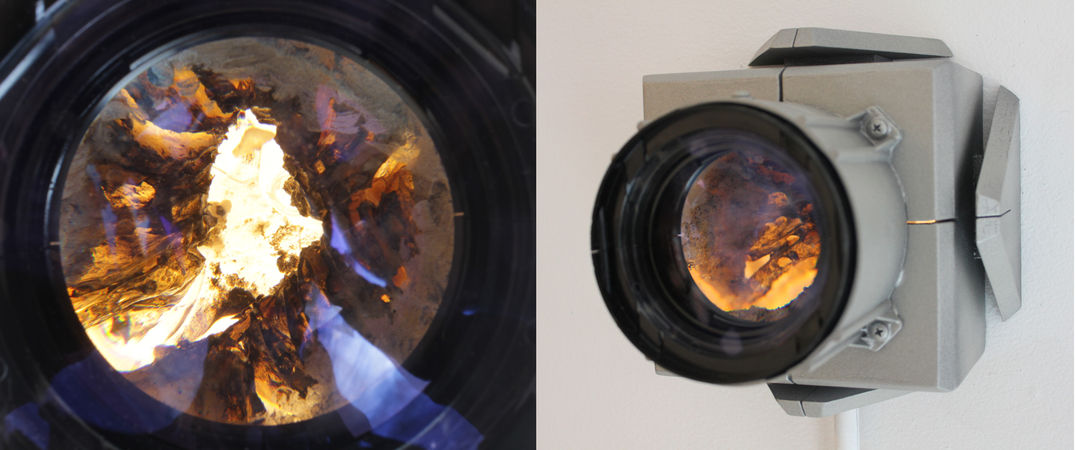“Abstract Geometries” curated by the Institute’s Matt Gosser is of the sculptures (and a few drawings) of Gianluca Bianchino and the paintings (and a few sculptures) of Kati Vilim, is taking place in Newark at the New Jersey Institute of Technology which has been an educational center in the city for a while; its institutional status as a school of design and architecture supports a good-size gallery space quite close to Newark’s Penn Station, which is within walking distance of the school. In this show, both Bianchino and Vilim, who are immigrants from Italy and Hungary, respectively, demonstrate considerable expertise in their vision and craft. Bianchino, living in Jersey City and working in Newark, and Vilim, living in Jersey City and maintaining a space in Chelsea in Manhattan, are artists long associated with northern New Jersey, where their efforts are well regarded. The problem, a major one for artists working in this area, stems from limited interest on the part of writers and magazines based in New York. This show, indicative of the best work done in the area, needs to be seen.
Bianchino has shown extensively in the area, including, including a 2014 exhibition, of a remarkable relief installation at the Firehouse Art Center, which surrounded three walls of the former firehouse, turned into a non-profit art space in Newark. A year ago, Vilim took part in a two-person show at Mucciaccio Gallery in Chelsea. Both artists are resolute abstractionists; Bianchino favors reliefs, regularly painted a bright single color, with parts of its surface cut out to reveal the wall behind it. He also makes sculptures lit from within. Vilim favors hard-edge abstract paintings, more and more brightly colored, in which shapes of various forms and hues overlap each other, crowding the compositional space with their mass. It is fair to say that the artists trade on the well-established legacy of geometric modernism, but they do so in very contemporary ways. The well-installed show gives us the chance to see mid-career artists, at the top of their achievement, working effectively.
Vilim’s work belongs to the tradition of abstract painting, a development first occurring in Western Europe. In “Daily Suggestions” (2021). Vilim has painted a composition filled with discrete geometric shapes that cover the canvas entirely. These shapes include a large, orange V-shaped figure on the right; a light blue plank, angled upward to the right, in the middle; and a slightly darker blue form, sharply bent in its center, so its shape looks like an upside-down V, on the left. These and the other elements in the painting don’t fit together like a puzzle so much as they jostle each other in their impressive array of forms. “Nothing Personal” (2021), simpler than “Daily Suggestions” in that there are not so many parts, presents an arrangement of mostly volumetric, planar shapes. They include a light blue plank moving upward in the middle; directly to the left is a three-dimensional yellow triangle, while off to the right is a large, red slab. The underlying intelligence of these paintings is essentially formal, as the title Nothing Personal suggests. This way of working contrasts, in its resolute formalism, with the often personally driven, politicized art being made now. Vilim is thus maintaining a tradition made honorable by time, and by the reticence—its distance from personal revelation—with which she is painting. The work is excellent.
Bianchino’s art often consists of a monochromatic, low-relief plane, embellished, and made more complicated by such effects as dowels, curving rods, and spaces cut out of the work, so that the white wall of the gallery is seen. In Mechanical Landscape in “Deep Blue” (2021), the overall dimensions of the composition are four feet square, and nine inches in depth. On the surface of the deep blue flat platform, we see straight dowels and curved ones, along with subtle cuts that turn the relief into a layered composition. In the center there is a jagged, straight-line opening that reveals the wall behind the work, as well as a solitary sphere set into the gap. Above it, on the left, is a smaller opening. Bianchino is right to call this a mechanical landscape, as the forms reveal a topography created by the kind of sharp angles one establishes when working with tools. In the lit, LED sculpture titled “Totem Lightmap” (2021), a tall rectangle, painted a dark gray and a deep, dark mauve, emanates light through openings, linear and curved, often in an oval fashion. It is a remarkable merger of fine art and basic, but effective, technology, aligning with geometric abstraction. Like Vilim, Bianchino is determined to render form in an objective manner, foregoing the personal element so popular at this time. His extremely skilled and attractive work does this very well.
To sum up, Vilim and Bianchino, now with a couple of decades of experience behind them, have come into a style of their own. We can’t tell what they will do next, but this fine show, in the outpost of Newark, finds them working at a high level. In our times of intense pluralism, any manner of working is acceptable. Vilim and Bianchino prove that older styles can be kept alive through intuitive strength and technical discipline. Even should one not gravitate to this kind of art, it must be acknowledged that the works evidence skills not seen so easily in current work. For this writer, though, the show is more than a mere recapitulation of an older style. Instead, it takes an established manner of working and leads it into the future. Given that fine art today seems to be highly political and often driven by advances in technology, or displays a casual approach that overlooks craft, Vilim and Bianchino deserve praise for having made beautiful art that stands outside social practice. Their efforts to come will likely be as original and well-made as the work now on exhibition.
Jonathan Goodman, March 3, 2022













